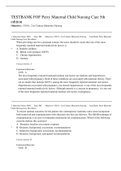Summary
Summary chapter 12 - Prejudice and intergroup relations (0HV30)
- Course
- Institution
- Book
Summary of chapter 12 (Prejudice and intergroup relations) of Social psychology and human nature by Baumeister and Bushman. The order of the book is followed, and the summary is based on the key words of the book. There is a table of contents, which may prove useful when searching for certain topic...
[Show more]











